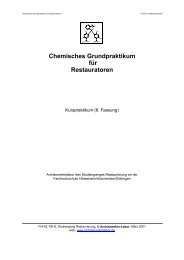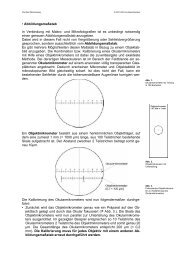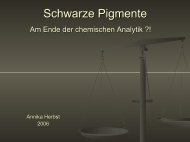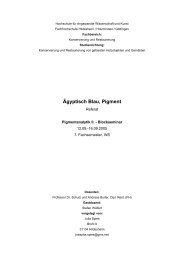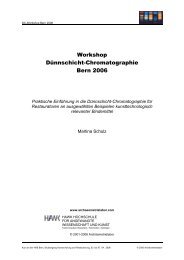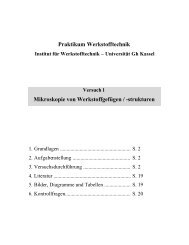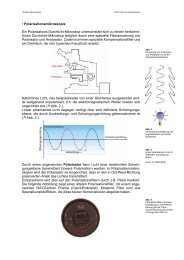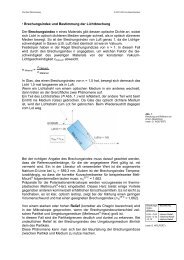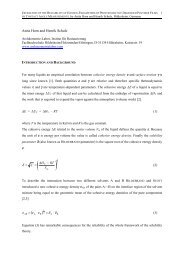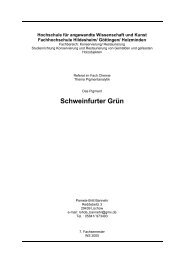Henrik Schulz* and Anita Horn, Archäomertrie-Labor der HAWK ...
Henrik Schulz* and Anita Horn, Archäomertrie-Labor der HAWK ...
Henrik Schulz* and Anita Horn, Archäomertrie-Labor der HAWK ...
Create successful ePaper yourself
Turn your PDF publications into a flip-book with our unique Google optimized e-Paper software.
Manuscript, H. Schulz <strong>and</strong> A. <strong>Horn</strong>, Hildesheim, henrik.schulz@archaeometrielabor.com 19<br />
This plot gives a good impression of the sensitive influence of the interaction parameter φ<br />
which is causing by the different test liquids. The test liquids No. 1 <strong>and</strong> No. 2 are strongly<br />
ionic (CaCl2/H2O) rather than the more polar <strong>and</strong> hydrogen bonding liquids No. 3 – 9<br />
(water/ethylene glycol mixtures). If we consi<strong>der</strong> only the latter series we receive an expected<br />
value of ∆π between 1 <strong>and</strong> 7 mNm -1 for the sample of spruce wood. In the same way we have<br />
estimated the value for the sample of beech wood: ∆π between 8 <strong>and</strong> 14 mNm -1 . These two<br />
value are compiled into the table 6 (last right column). If we compare the values of ∆π with<br />
those of ∆γc,max they correspond in good agreement for both wood species. The reliability of<br />
the equation of state (eq. (7)) <strong>and</strong> the adsorption therm (eq. (8)) is given in practice an we set<br />
∆γc,max = ∆π . If we do so, finally we can estimate the number ∆N of activated functional<br />
groups onto the wooden surface that are created by the plasma treatment. We use eq. (6):<br />
⎛ 1 ⎞ ⎛ ∆π<br />
⎞<br />
∆N = ⎜<br />
⎟ ⎜ ⎟ λ 0 ⋅ λ 1<br />
⎝ hc<br />
⎠ ⎝ ∆λ<br />
⎠<br />
With the data given in the tables 5. <strong>and</strong> 6. the following values of ∆N were calculated <strong>and</strong> are<br />
summarized in table 7.<br />
Table 7: Summary of the experimental data (see table 5 <strong>and</strong> 6) for the estimation of the<br />
increase of the number of activated surface groups ∆N by plasma treatment<br />
(beech <strong>and</strong> spruce wood)<br />
wood λ0 [nm] λ1 [nm] ∆λ [nm] ∆π [mNm -1 ] ∆N [cm -2 ]<br />
beech 599 588 11 8 1,3 10 14<br />
(6)<br />
14 2,3 10 14<br />
spruce 591 567 24 1 7,1 10 12<br />
7 5,0 10 13<br />
The magnitude of the estimated ∆N is of reasonable or<strong>der</strong> for surface groups of isolators [20].<br />
Unfortunately no details about the number of hydroxy groups onto the surface of cellulose or<br />
wood were given or found in literature resp. We found in the literature for the number of<br />
hydroxy groups onto surfaces of SiO2 5⋅10 14 cm -2 <strong>and</strong> Al2O3 8⋅10 14 cm -2 [21].



